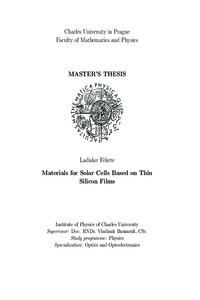Materiály pro sluneční články založené na tenkých vrstvách křemíku
Materials for Solar Cells Based on Thin Silicon Films
rigorózní práce (UZNÁNO)

Zobrazit/
Trvalý odkaz
http://hdl.handle.net/20.500.11956/4853Identifikátory
SIS: 44403
Kolekce
- Kvalifikační práce [10921]
Autor
Fakulta / součást
Matematicko-fyzikální fakulta
Obor
Optika a optoelektronika
Katedra / ústav / klinika
Fyzikální ústav UK
Datum obhajoby
31. 10. 2006
Nakladatel
Univerzita Karlova, Matematicko-fyzikální fakultaJazyk
Čeština
Známka
Uznáno
Thin lm microcrystalline silicon is the most promising materiál for large area PN junction solar cells. As microcrystalline silicon is a heterogenous material composed of two phases (amorphous silicon tissue from which crystalline grains of micrometric dimension grow). The Raman spectra are commonly used to determine the crystallinity of mixed phase silicon thin lms by analyzing the contributions of amorphous and crystalline phase to TO phonon band. Many dierent empirical or semi-empirical methods of evaluating crystallinity from the Raman spectra exist. In this master's thesis the microcrystalline Raman spectra were studied and a better way of evaluating crystallinity was searched for. The decomposition of the microcrystalline spectra of the series of the samples, where a single deposition parameter was changing,by tting them with Gaussian bands was performed. We also report on the development of a special software for the band decomposition by non-linear least-squares tting based on Marquardt-Levenberg algorithm and demonstrate its use for a series of lms with structure changing from amorphous to fully microcrystalline.
